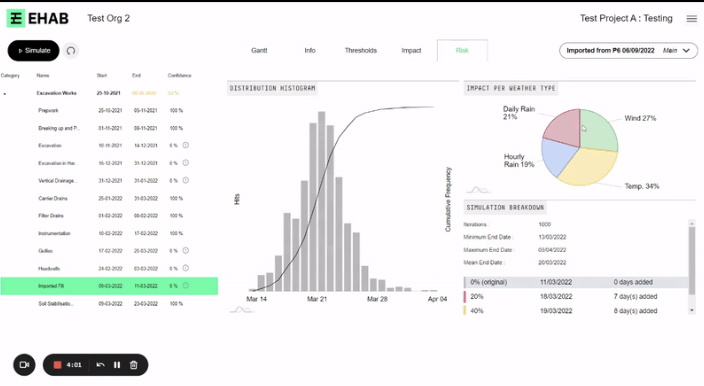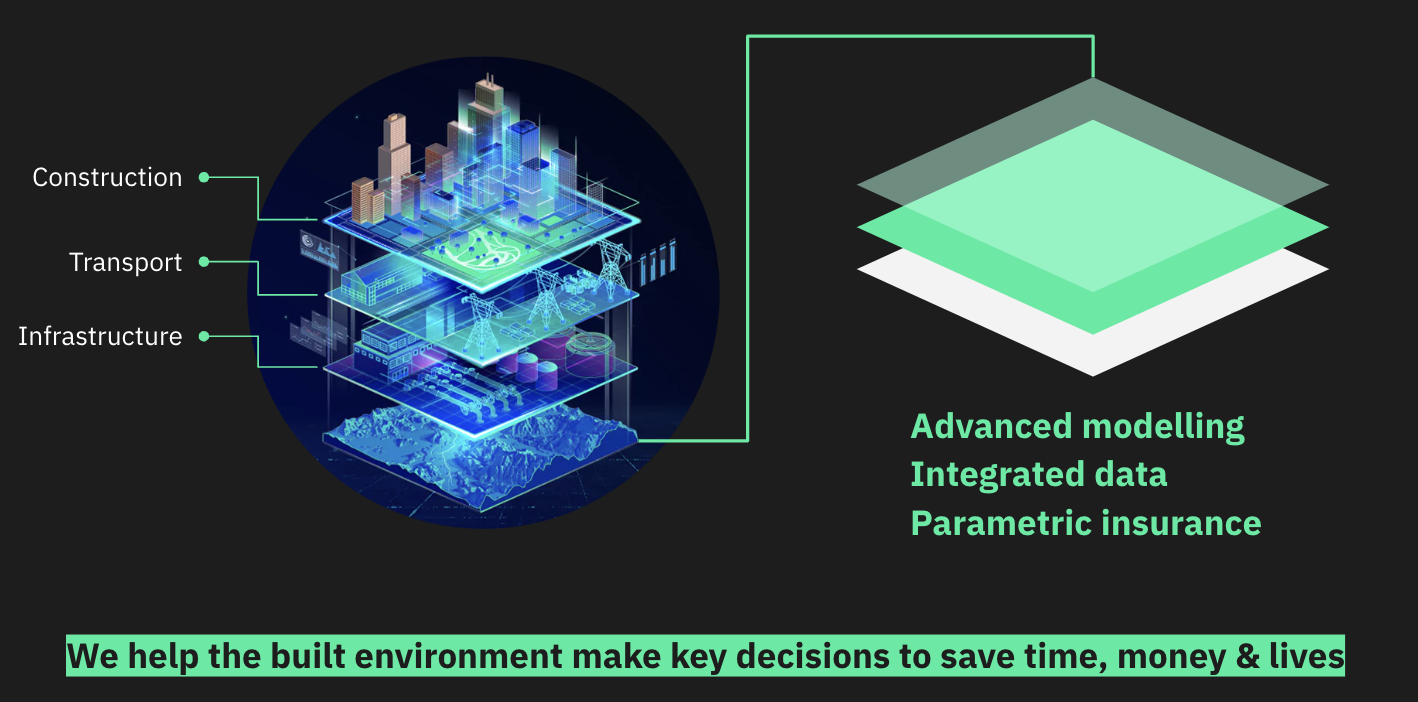Introduction
Why has Quantitative Schedule Risk Analysis become
the go-to for construction professionals?
In the intricate & complicated world of construction, predicting and managing risks is paramount. One tool that has emerged as a go to tool to establish clarity in this realm is Quantitative Schedule Risk Analysis (QSRA). But what is Quantitative Schedule Risk Analysis, and why has it become the go-to for construction professionals? And why is the way it deals with weather risk such a problem for those professionals trying to establish certainty in their project timelines? That’s what this blog is all about; what is the big problem with how Quantitative Schedule Risk Analysis deals with weather risks and risk events.

What is QSRA?
Quantitative Schedule Risk Analysis (QSRA) is a technique used to assess the potential impact of risks and uncertainties on a project's schedule. By quantifying the potential delays and disruptions, QSRA provides a probabilistic assessment of project completion dates, allowing stakeholders to make more informed decisions. The process for completing a QSRA looks something like this:- Review Existing Schedule: Start by reviewing your existing project schedule to ensure it's up-to-date and accurately reflects the scope of work, task dependencies, and milestones. You might be using P6, Microsoft Project, Asta Power Project or another similar scheduling tool.
- Identify Risk Factors: Document specific risks and uncertainties that could impact the schedule. This could range from labour strikes to weather conditions (this is what happens in the traditional process).
- Assign Probabilities: For each identified risk, assign a probability of occurrence. This could be a percentage or a qualitative measure (e.g., low, medium, high).
- Input Data into QSRA Software: Use specialised software to input your refined schedule and risk data. You’ll probably be using Acumen Risk, Safran Risk, Nodes & Links or possibly Primavera Risk Analysis, there are many other softwares that can be used as well.
- Run Monte Carlo Simulations: The software will execute the Monte Carlo simulation to generate a range of possible outcomes based on the risks and uncertainties you've identified. This is a statistical process that takes all your assumed risks into account.
- Analyse Output: Review the simulation results to understand the probability distribution for your project milestones and completion date. Pay attention to the P50, P80, and P90 values, which represent different confidence levels for your schedule.
- Discuss Findings with Stakeholders: Share the results with project stakeholders to align expectations and make informed decisions.
- Develop Mitigation Plans: Create action plans for the most impactful risks. This could involve adding buffer time, reallocating resources, or modifying task sequences.
- Update Schedule: Incorporate the findings and mitigation plans back into the project schedule.
- Monitor and Update: As the project progresses, continuously update the QSRA with actual performance data and re-run the analysis to adjust for any changes in the risk landscape.

Why is QSRA so popular?
The construction industry is riddled with uncertainties. From unforeseen site conditions to supply chain disruptions, projects can easily go off track. QSRA offers a systematic approach to understanding these uncertainties. By providing a clearer picture of potential delays, it allows for better contingency planning, resource allocation, and stakeholder communication. In essence, QSRA equips project managers with a data-driven lens to foresee and mitigate potential pitfalls.
QSRA in Today's Construction
Modern construction projects, with their multifaceted nature, demand a robust risk management strategy. QSRA is now often integrated into the early stages of project planning. It aids in identifying critical risks, prioritizing them, and developing mitigation strategies. As projects evolve, QSRA can be revisited to account for new risks, ensuring that the project remains on track.

Main Tools for QSRA
Several tools have been developed to facilitate QSRA in construction. Some of the prominent ones include:- Primavera Risk Analysis (PRA): A comprehensive tool that integrates with project management software to provide advanced risk analytics.
- @RISK: A popular add-on for Microsoft Excel, it offers Monte Carlo simulation to assess risks.
- Risk: A tool tailored for project risk analysis and management, offering both qualitative and quantitative analysis capabilities.
- Acumen Risk: A leading solution for QSRA in the industry.
- Safran Risk: Another leading tool that is used across onshore and offshore projects.
The Glaring Gap - Weather Risk
Despite the sophistication of QSRA tools, one significant source of uncertainty remains inadequately addressed: weather risk. Weather conditions, from unexpected rainfall to extreme temperatures, can severely disrupt construction schedules. Yet, most QSRA tools offer only rudimentary weather risk analysis, if at all. IN some cases they offer tools, but leave it up to the users to source the data and this adds complexity and margin for error.
This oversight is particularly concerning given that weather-related disruptions are among the most common and impactful risks in construction. It's also concerning given that climate change is making weather more extreme and a lot more volatile. So now is exactly the time when planning and risk leaders should be thinking about how they can better incorporate these risks into their processes.
One cautionary tale about
weather risk in QSRA
The Queensferry Crossing serves as a cautionary tale for the underestimation of weather risks in Quantitative Schedule Risk Analysis (QSRA). Originally slated for completion in December 2016, the bridge's opening was delayed due to severe wind conditions that hampered construction activity. Despite an ambitious plan by Forth Crossing Bridge Constructors (FCBC) that accounted for a 25% downtime due to weather, they faced a 40% downtime, especially during critical stages of construction that were sensitive to wind.
While FCBC implemented multiple contingencies such as additional staffing and altered methodologies, these measures reached a point of diminishing returns due to the intricate and sequential nature of the remaining tasks. This case underscores the crucial need for sophisticated weather risk management tools in QSRA to improve resilience, planning, and financial predictability in infrastructure projects. This resulted in large costs and losses for the contracting joint venture.
Why Current QSRA Weather Analysis
Is Inadequate
Current QSRA software solutions commonly require users to manually input data to account for weather-related risks. These platforms typically allow for the inclusion of weather events, such as Snow, Rain, and Wind, based on averaged probabilities acquired from freely available online sources. This approach overlooks three critical aspects:
- Relevance of Risks to Specific Activities: Construction activities have varying sensitivities to different weather conditions. The traditional QSRA model, which usually relies on manual data entry, fails to capture the nuanced interplay between specific weather events and individual construction tasks. This results in a significant margin of error when assessing weather risks.
- Quality of Data Source: Even if planners take the initiative to gather weather data themselves, the quality and granularity of this data are often subpar. Typically, information is pulled from the nearest weather station, introducing inaccuracies due to geographical and topographical differences between the station and the construction site.
- Impact of Climate Change: In the UK, it's common practice to use Met Office records for weather data. However, these records are usually dated from 1979 to 2010. This outdated range omits the most recent decade, which is crucial for understanding the evolving risks posed by climate change. Expecting planners to manually incorporate the complexities of climate change into QSRA models is unrealistic.

Introducing EHAB:
A Robust Climate Resilience Layer
for Risk Managers and Planners
The EHAB platform streamlines the incorporation of high-quality climate and weather insights into your project planning. By simply entering a location, users gain immediate access to an array of nuanced, location-specific climate data. Further customization is possible through the input of project activities, allowing the platform to refine its insights accordingly. Once a complete construction plan is uploaded, EHAB generates climate-adjusted weather calendars that span the entire project duration. Unlike conventional systems that merely match weather types, EHAB focuses on the specific types of construction activities, enabling a more dynamic understanding of weather impact. The platform also accommodates for less common but impactful weather metrics like wave height, visibility, and wind gusts.
EHAB's data seamlessly integrates into standard QSRA processes, drastically reducing the time and effort required for comprehensive risk assessment. What could have taken days can now be accomplished in as little as 30 minutes. Moreover, EHAB is in constant development, continually enhancing data quality and user experience. The platform offers compatibility with various risk management tools, including OPRA, Acumen Risk, and Safran Risk, with upcoming integrations such as Nodes & Links on the horizon. So if you've struggled to make sense of weather data, or if you've spent hours manually working through meteorological analyses, EHAB offers a powerful, efficient alternative.
Want to book a demo to find out how this could work for your QSRA process? Book here.
Conclusion
Our aim at EHAB is to build a data layer that plugs into all of your softwares and give you the data you need in the place you need it to make smart and resilient decisions about your project. This could be at the design stage, at the ECI stage, at bid, detailed planning, construction or even operation.
Climate resilience needs to be embedded into the way every project works, but we need to do this in a light touch way that adds as little burden as possible. Ideally it enhances the way work happens, to minimise risks, increase profits and protect workers and the public.





.jpg?width=352&name=pexels-islandhopper-x-15689819%20(1).jpg)